Standard lists of history’s most influential religious leaders – among them Abraham, Moses, Jesus, Muhammad, Siddhartha Gautama (the Buddha) – tend to be predominantly, if not exclusively, male. Many religious groups, including Roman Catholics and Orthodox Jews, allow only men to be clergy, while others, including some denominations in the evangelical Protestant tradition, have lifted that restriction only in recent decades. Yet it often appears that the ranks of the faithful are dominated by women.
Noting similar gender differences in other countries, mainly in Europe, some social scientists have argued that women are universally more religious than men across all societies, cultures and faiths.1 More controversially, a few sociologists have theorized that the gender gap in religion is biological in nature, possibly stemming from higher levels of testosterone in men or other physical and genetic differences between the sexes.2
How and why men and women differ in religious commitment has been a topic of scholarly debate for decades. Even today, it continues to inspire much academic research, as well as discussions among the general public. To contribute to this ongoing conversation, Pew Research Center has amassed extensive data on gender and religion in six different faith groups (Christians, Muslims, Buddhists, Hindus, Jews and the religiously unaffiliated) across scores of countries, including many with non-Christian majorities. Data on affiliation in 192 countries were collected from censuses, demographic surveys and general population surveys as part of the Center’s multiyear study projecting the size and geographic distribution of the world’s major religious groups from 2010 to 2050. 3 Data on religious beliefs and practices come from international Pew Research Center surveys of the general population in 84 countries conducted between 2008 and 2015.4
On all the standard measures of religious commitment examined in the study, Christian women are more religious than Christian men. By contrast, Muslim women and Muslim men show similar levels of religiousness on all measures of religious commitment except frequency of attendance at worship services. Because of religious norms, Muslim men attend services at a mosque much more often than Muslim women do.
Varieties of religious commitment
Measuring levels of religious commitment in widely differing societies and faiths is a tricky endeavor. Rather than trying to use a single indicator, this report looks at a variety of measures of commitment, including religious affiliation, frequency of worship service attendance, frequency of prayer, and whether religion plays an important role in a person’s life. Depending on the specific measure, data are available for varying numbers of countries because not all surveys asked the exact same questions.
Globally, women somewhat more likely to affiliate with a religious faith
In 61 of the 192 countries, women are at least 2 percentage points more likely than men to have an affiliation. In the remaining countries, women and men display roughly equal levels of religious affiliation because in many cases nearly all people of both genders identify with some religious group. There are no countries in which men are more religiously affiliated than women by 2 percentage points or more.5
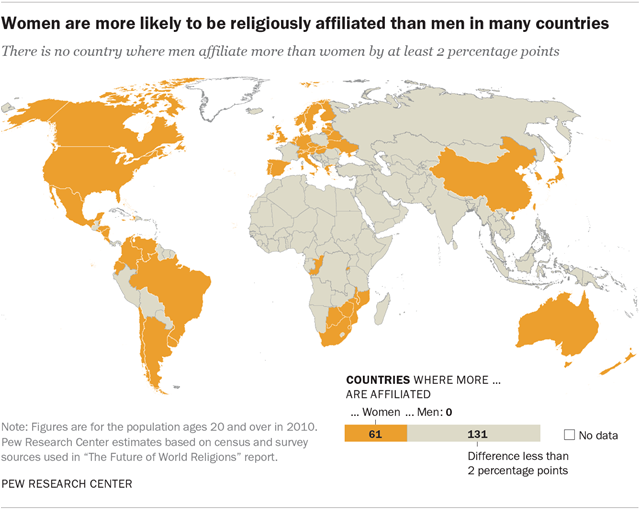
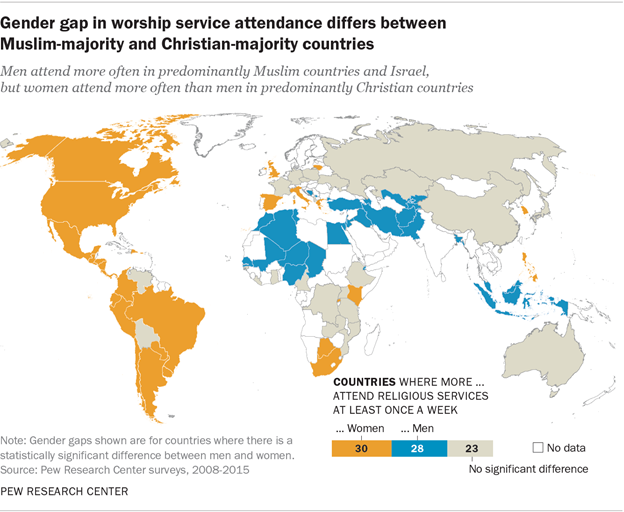
Among Christians, women attend religious services more often, but among Muslims and Orthodox Jews, men attend more often
Another useful indicator of religious commitment is how often women and men say they attend religious worship services. The biggest exceptions to the overall pattern of women exceeding men in religious commitment can be found on this measure. Among Christians in many countries, women report higher rates of weekly church attendance than men. But among Muslims and Orthodox Jews, men are more likely than women to say they regularly attend services at a mosque or synagogue.6 Higher levels of weekly attendance among Muslim and Jewish men are due in large part to religious norms that prioritize men’s participation in worship services. In Orthodox Judaism, communal worship services cannot take place unless a minyan, or quorum of at least 10 men, is present. And in most Islamic societies, Muslim men are expected to attend communal Friday midday prayers in the mosque, while women can fulfill this obligation individually, either inside or outside the mosque.
Worldwide, this results in a mixed attendance pattern. Out of 81 countries where Pew Research Center surveys have asked about worship service attendance, women report greater levels of weekly attendance in 30 countries, most of which have Christian majorities or large Christian populations. In 28 countries – mostly places with Muslim majorities or large Muslim populations – men report greater weekly attendance than women. In the remaining 23 countries, the difference between women and men in self-reported attendance is not statistically significant.
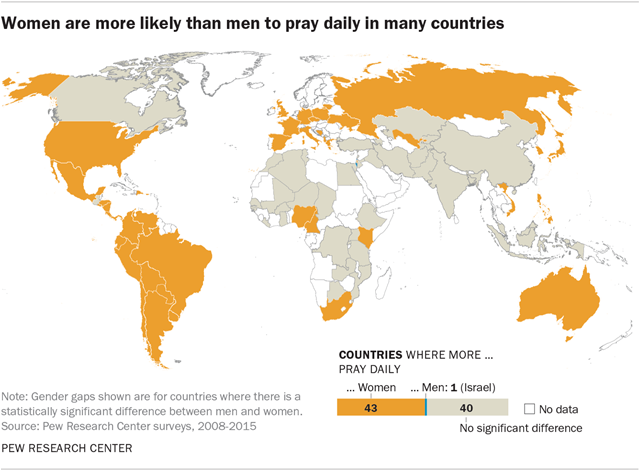
Generally, more women than men pray daily
Another measure of religious commitment concerns prayer, which can take place privately as well as publicly. Pew Research Center surveys have asked people in 84 countries how often they pray. In about half of those countries (43), substantially more women than men say they pray on a daily basis. Only in Israel, where roughly 22% of all Jewish adults self-identify as Orthodox, does a higher percentage of men than women report engaging in daily prayer. In the remaining countries, women and men are about equally likely to say they pray daily.
The difference between women and men in self-reported rates of daily prayer is the biggest average gender gap found in this study. Across the 84 countries for which data are available, the average share of women who say they pray daily is 8 percentage points higher than the average share of men. Even religiously unaffiliated women in some countries, including the United States and Uruguay, report praying daily at higher rates than unaffiliated men do.
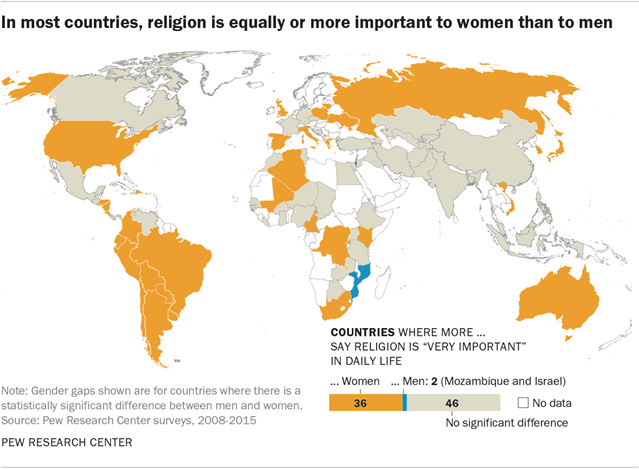
Religion equally or more important to women than to men
Many Pew Research Center international surveys ask people to assess the importance of religion in their daily lives. Is religion very important, somewhat important, not too important or not at all important to them? In 46 of the 84 countries for which data are available, women and men are about equally likely to say religion is “very important” in their lives. But in 36 other countries, women are more likely than men to regard religion as very important – often by notably large margins. Only in Israel and Mozambique are men more likely than women to consider religion very important to them personally.
Women and men about equally likely to believe in heaven, hell and angels
Another way to measure religiousness is to look at what people believe. Survey data from 63 countries regarding beliefs in heaven, hell and angels indicate that men and women usually display similar levels of belief in these concepts. For example, out of 63 countries, both genders are equally likely to believe in heaven in 47 countries and to believe in hell in 52 countries. But where there is a discernible gender gap, women are more likely than men to believe in these concepts. For example, women are more likely than men to say they believe in heaven in 15 countries and more likely than men to say they believe in hell in 10 countries. Women also are more likely to say they believe in angels in 14 of 63 countries. There are a few exceptions: Men are more likely than women to believe in heaven and hell in Lebanon and to believe in angels in Pakistan.
Christian and Muslim gender gaps differ
By most key measures of religious commitment, Muslim men and women are more alike in their levels of religiousness than are Christian men and women. For example, in the 40 countries where data were collected on Muslims’ prayer habits, Muslim women report praying daily more often than Muslim men by an average difference of only 2 percentage points. A similar pattern occurs in religion’s importance. There is virtually no difference between the shares of Muslim women and Muslim men who say religion is “very important” to them in the 40 countries with data on this topic. When it comes to weekly attendance at religious services, however, the pattern is very different: Muslim men are more likely than Muslim women to regularly attend services by an average of 28 percentage points across the 39 countries where Muslim attendance data were collected.
To explore gender differences in religious commitment among general populations as well as among Christians and Muslims, check out this interactive.
By contrast, the gender gaps between Christian women and Christian men are more consistent than the Muslim gender gaps. Across all measures of religious commitment, Christian women are more religious than Christian men, often by considerable margins. In the 54 countries where data were collected on Christians’ daily prayer habits, Christian women report praying daily more frequently than Christian men by an overall average gap of 10 percentage points. In 29 of those countries, more women than men reported praying daily by margins of 10 percentage points or more, ranging upward to 25 points in Greece.7 Similarly, Christian women are more likely than Christian men to say religion is “very important” to them by an overall average of 7 percentage points across 54 countries. In 15 of those countries, more women than men say this by margins ranging from 10 percentage points in Peru, Chile and the United States to 23 points in South Korea. When it comes to attendance at worship services, Christian women are, on average, 7 percentage points more likely than Christian men to report attending services weekly across 53 countries with data on Christian attendance patterns.8
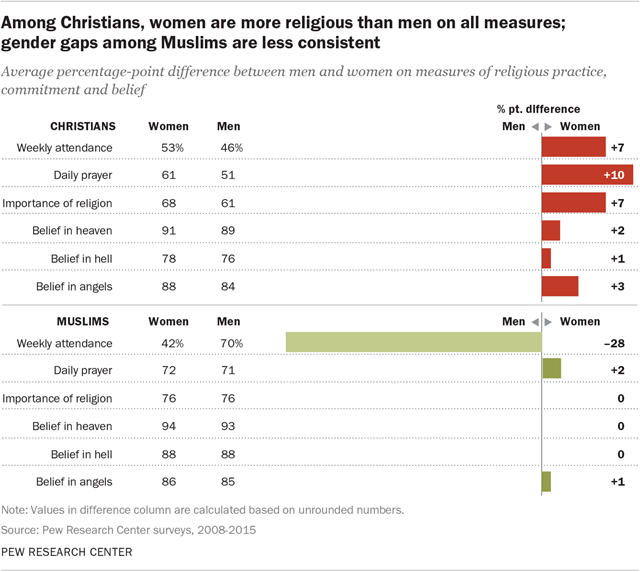
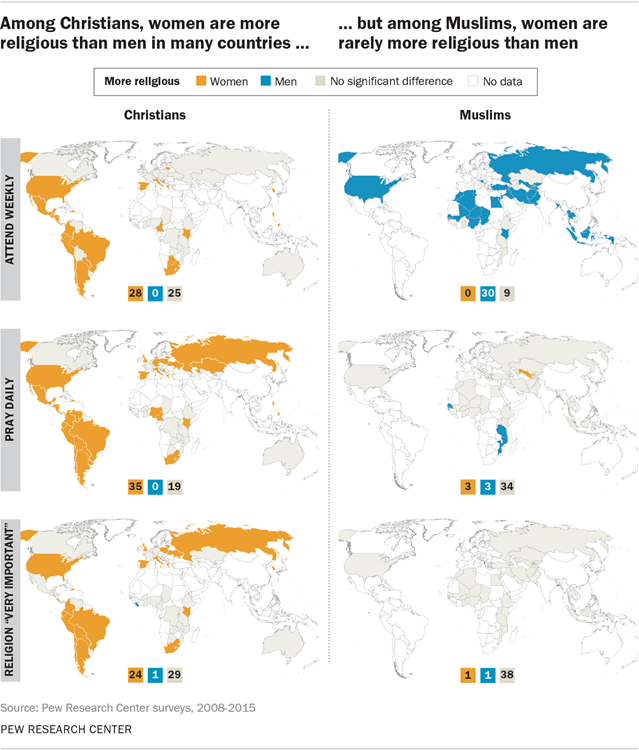
Explaining the religious gender gap
Scholars of religion have been examining possible reasons for the gender gaps in religious commitment for some time. They have advanced many different theories, which cover a wide range of sources: biology, psychology, genetics, family environment, social status, workforce participation and a lack of “existential security” felt by many women because they generally are more afflicted than men by poverty, illness, old age and violence. Lately, a growing consensus in the academic community is that the religious gender gap probably stems from a confluence of multiple factors. But there is still no agreement on exactly which factors are most responsible for the gender differences.
Chapter 7 of this report outlines some possible explanations scholars have suggested for the religious gender gap. It also discusses a Pew Research Center analysis of data looking at a possible link between women’s religious commitment levels and their labor force participation (see page 59). Women who participate in the labor force tend to show lower levels of religious commitment than women who do not work outside the home for pay. As a result, when these two groups of women are compared with men (most of whom are in the labor force), the gender gaps differ. Indeed, Pew Research Center’s analysis finds the gap between women who are in the labor force and men tends to be smaller than the gap between women who are not in the labor force and men. This pattern holds even after accounting for other factors that are also associated with religious commitment, such as education level, age and marital status. Moreover, further analysis shows that across predominantly Christian countries, the overall gender gaps in daily prayer and importance of religion are smaller in countries where more women are in the labor force.
That analysis, along with the finding that women are not universally more religious than men, lends support to explanations of the religious gender gap that include “nurture” (i.e., social and cultural forces) and not just “nature” (i.e., biological or evolutionary forces). By drawing on data from more Muslim-majority countries and non-European countries than previous studies, this report demonstrates that the gender gap is not consistent across societies or religious traditions; differences in religious commitment between men and women vary considerably around the globe. This does not mean explanations that lean heavily on “nature” might not also help explain the religious gender gap and its prevalence throughout the world. But it does suggest that social and cultural factors, such as religious traditions and workforce participation, play an important role in shaping the religious gender gap.
Other key findings in this report include:
- The gender gaps among Christians, as well as some gender differences in other faith traditions, vary in size in different regions of the world. This suggests that while gender differences in religious commitment may be driven in part by the teachings of a particular religion, they also may reflect national habits or cultural views intrinsic to a particular part of the world. In sub-Saharan Africa, for example, the study finds only minor gender differences in both Christian and Muslim populations (with the exception of weekly worship attendance) because of the generally high degree of religious commitment among both genders. For example, in Ghana, 89% of Christian women and men say religion is very important in their daily lives, as do 98% of Muslim women and 96% of Muslim men. In Latin America and the United States, by contrast, the gender gaps among Christians on religion’s importance and daily prayer are noticeably wider than they are in sub-Saharan Africa. In Argentina, for example, there is a 20-point gap between men and woman on self-reported rates of daily prayer – 32.5% of Christian men report praying daily, compared with 52.9% of Christian women.
- Men and women in the United States differ from each other in their levels of religious commitment to a greater extent than men and women differ in other economically advanced countries for which data are available, including Canada and the United Kingdom. And while American men generally display less religious commitment than American women, both genders are more religious than men and women in other economically advanced countries.
- In the United States, the pattern of women being more religious also appears among the unaffiliated (people who identify as atheist, agnostic or “nothing in particular” and sometimes are called the “nones”). Fewer American women than men (19% vs. 27%) are religiously unaffiliated. Moreover, unaffiliated women report higher levels of engagement with religion than unaffiliated men across several indicators, including weekly attendance at religious services (5% vs. 3%), daily prayer (26% vs. 15%) and saying religion is very important to them (15% vs. 12%).9
A note about this analysis
This report highlights country-level differences in religious commitment between men and women that pass conventional tests of statistical significance – that is, there is at least a 95% confidence level that the observed differences are not due to sampling error, after taking into account the size of the sample and the design effects of the survey. On some charts, gender differences that may appear to be large are labeled as not statistically significant because of small sample sizes of women and men in particular religious groups. Data for a particular religious group in each country are used only if that group had at least 300 survey respondents. Except for the measure of religious affiliation, countries are weighted equally when presenting the average gender gap across a number of countries – that is, the size of their populations is not factored into the calculations. In the case of religious affiliation, the population size of each country is considered when computing country and global averages.